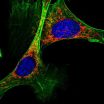(Press-News.org) Blocking a pain receptor in mice not only extends their lifespan, it also gives them a more youthful metabolism, including an improved insulin response that allows them to deal better with high blood sugar.
"We think that blocking this pain receptor and pathway could be very, very useful not only for relieving pain, but for improving lifespan and metabolic health, and in particular for treating diabetes and obesity in humans," said Andrew Dillin, a professor of molecular and cell biology at the University of California, Berkeley, and senior author of a new paper describing these results. "As humans age they report a higher incidence of pain, suggesting that pain might drive the aging process."
The "hot" compound in chili peppers, capsaicin, is already known to activate this pain receptor, called TRPV1 (transient receptor potential cation channel subfamily V member 1). In fact, TRPV1 is often called the capsaicin receptor. Constant activation of the receptor on a nerve cell results in death of the neuron, mimicking loss of TRPV1, which could explain why diets rich in capsaicin have been linked to a lower incidence of diabetes and metabolic problems in humans.
More relevant therapeutically, however, is an anti-migraine drug already on the market that inhibits a protein called CGRP that is triggered by TRPV1, producing an effect similar to that caused by blocking TRPV1. Dillin showed that giving this drug to older mice restored their metabolic health to that of younger mice.
"Our findings suggest that pharmacological manipulation of TRPV1 and CGRP may improve metabolic health and longevity," said Dillin, who is a Howard Hughes Medical Institute investigator and the Thomas and Stacey Siebel Distinguished Chair in Stem Cell Research. "Alternatively, chronic ingestion of compounds that affect TRPV1 might help prevent metabolic decline with age and lead to increased longevity in humans."
Dillin and his colleagues at UC Berkeley and The Salk Institute for Biological Studies in La Jolla, Calif., will publish their results in the May 22 issue of the journal Cell.
Pain and obesity
TRPV1 is a receptor found in the skin, nerves and joints that reacts to extremely high temperatures and other painful stimuli. The receptor is also found in nerve fibers that contact the pancreas, where it stimulates the release of substances that cause inflammation or, like CGRP (calcitonin gene-related peptide), prevent insulin release. Insulin promotes the uptake of sugar from the blood and storage in the body's tissue, including fat.
Past research has shown that mice lacking TRPV1 are protected against diet-induced obesity, suggesting that this receptor plays a role in metabolism. Disrupting sensory perception also increases longevity in worms and flies. But until now, it was not known whether sensory perception also affects aging in mammals.
Dillin and his team have now found that mice genetically manipulated to lack TRPV1 receptors lived, on average, nearly four months – or about 14 percent – longer than normal mice. The TRPV1-deficient mice also showed signs of a youthful metabolism late in life, due to low levels of CGRP — a molecule that blocks insulin release resulting in increased blood glucose levels and thus could contribute to the development of type 2 diabetes. Throughout aging, these mice showed improved ability to quickly clear sugar from the blood as well as signs that they could burn more calories without increasing exercise levels.
Moreover, old mice treated with the anti-migraine drug, which inhibits the activity of CGRP receptors, showed a more youthful metabolic profile than untreated old mice.
UC Berkeley and The Salk Institute filed a patent May 16 on the technology described in the Cell paper. Dillin plans to continue his studies of the effects of TRPV1 and CGRP blockers on mice and, if possible, humans.
INFORMATION:
Dillin's coauthors are Celine E. Riera, Jonathan Halloran and Roger Van Andel of UC Berkeley and Mark O. Huising, Patricia Follett, Mathias Leblanc, Carlos Daniel de Magalhaes Filho and Carsten Merkwirth of The Glenn Center for Aging Research and The Salk Institute for Biological Studies.
The work was supported by the Glenn Foundation for Medical Research and the Howard Hughes Medical Institute.
Blocking pain receptors extends lifespan, boosts metabolism in mice
Pain receptors may hold key to treating obesity and diabetes and improving metabolic health
2014-05-22
ELSE PRESS RELEASES FROM THIS DATE:
One molecule to block both pain and itch
2014-05-22
Duke University researchers have found an antibody that simultaneously blocks the sensations of pain and itching in studies with mice.
The new antibody works by targeting the voltage-sensitive sodium channels in the cell membrane of neurons. The results appear online on May 22 in Cell.
Voltage-sensitive sodium channels control the flow of sodium ions through the neuron's membrane. These channels open and close by responding to the electric current or action potential of the cells. One particular type of sodium channel, called the Nav1.7 subtype, is responsible for ...
Deciphered the process through which cells optimize metabolism to burn sugars or fats
2014-05-22
To guarantee efficient use of nutrients, cells have systems that permit them to capture and transport the available nutrient molecules to their interior. But if several nutrients are available, cells can select those that are of most interest and discard undesired molecules.
Inside cells, nutrients are conducted to the mitochondria, the specialized cell organelles in which nutrients are combusted to release the energy held in their chemical bonds. Both sugars (glucose) and fats (fatty acids) are 'burned' in mitochondria, but these organelles need to adjust their molecular ...
New insight into stem cell development
2014-05-22
The world has great expectations that stem cell research one day will revolutionize medicine. But in order to exploit the potential of stem cells, we need to understand how their development is regulated. Now researchers from University of Southern Denmark offer new insight.
Stem cells are cells that are able to develop into different specialized cell types with specific functions in the body. In adult humans these cells play an important role in tissue regeneration. The potential to act as repair cells can be exploited for disease control of e.g. Parkinson's or diabetes, ...
Study: Some pancreatic cancer treatments may be going after the wrong targets
2014-05-22
ANN ARBOR, Mich. — New research represents a significant change in the understanding of how pancreatic cancer grows – and how it might be defeated.
Unlike other types of cancer, pancreatic cancer produces a lot of scar tissue and inflammation. For years, researchers believed that this scar tissue, called desmoplasia, helped the tumor grow, and they've designed treatments to attack this.
But new research led by Andrew D. Rhim, M.D., from the University of Michigan Comprehensive Cancer Center, finds that when you eliminate desmoplasia, tumors grow even more quickly and ...
'I can' mentality goes long way after childbirth
2014-05-22
The way a woman feels about tackling everyday physical activities, including exercise, may be a predictor of how much weight she'll retain years after childbirth says a Michigan State University professor.
James Pivarnik, a professor of kinesiology and epidemiology at MSU, co-led a study that followed 56 women during pregnancy and measured their physical activity levels, along with barriers to exercise and the ability to overcome them.
Six years later, the research team followed up with more than half of the participants and found that the women who considered themselves ...
What is being said in the media and academic literature about neurostimulation?
2014-05-22
Over the past several decades, neurostimulation techniques such as transcranial direct current stimulation (tDCS) have gradually gained favour in the public eye. In a new report, published yesterday in the prestigious scientific journal Neuron, IRCM ethics experts raise important questions about the rising tide of tDCS coverage in the media, while regulatory action is lacking and ethical issues need to be addressed.
TDCS is a non-invasive form of neurostimulation, in which constant, low current is delivered directly to areas of the brain using small electrodes. Originally ...
EuroPCR 2014 examines whether science translates into practice with new session format
2014-05-22
22 May 2014, Paris, France: The value of analysing published clinical trials and the benefit of informed discussion were highlighted yesterday when the ACCOAST trial data were discussed in a new session format—Will this trial change my practice?— at EuroPCR 2014. ACCOAST trial results demonstrate that pre-treatment with prasugrel in NSTEMI patients undergoing percutaneous coronary intervention (PCI) is inferior to treatment with the drug after angiography. Several other trials are also being scrutinised in the same format, which ends with a discussion with the audience ...
New details on microtubules and how the anti-cancer drug Taxol works
2014-05-22
A pathway to the design of even more effective versions of the powerful anti-cancer drug Taxol has been opened with the most detailed look ever at the assembly and disassembly of microtubules, tiny fibers of tubulin protein that form the cytoskeletons of living cells and play a crucial role in mitosis. Through a combination of high-resolution cryo-electron microscopy (cryo-EM) and new methodology for image analysis and structure interpretation, researchers with the Lawrence Berkeley National Laboratory (Berkeley Lab) and the University of California (UC) Berkeley have produced ...
Which way is up?
2014-05-22
What do sled dogs and cell clusters have in common? According to research by UC Santa Barbara's Denise Montell, they both travel in groups and need a leader to make sure they all follow in the same direction.
Montell, Duggan Professor of Molecular Cellular and Developmental Biology, and colleagues worked on three independent projects involving E-cadherin, a protein found in epithelial cells throughout the body. The researchers used fruit-fly ovaries to uncover the role played by E-cadherin in collective cell migration. Their findings are reported today in the journal ...
Eumelanin's secrets
2014-05-22
CAMBRIDGE, Mass-- Melanin — and specifically, the form called eumelanin — is the primary pigment that gives humans the coloring of their skin, hair, and eyes. It protects the body from the hazards of ultraviolet and other radiation that can damage cells and lead to skin cancer, but the exact reason why the compound is so effective at blocking such a broad spectrum of sunlight has remained something of a mystery.
Now researchers at MIT and other institutions have solved that mystery, potentially opening the way for the development of synthetic materials that could have ...
LAST 30 PRESS RELEASES:
Young adults commonly mix cannabis with nicotine and tobacco
Comprehensive review illuminates tau protein's dual nature in brain health, disease, and emerging psychiatric connections
Book prepares K-12 leaders for the next public health crisis
Storms in the Southern Ocean mitigates global warming
Seals on the move: Research reveals key data for offshore development and international ecology
Sports injuries sustained during your period might be more severe
World's first successful 2 Tbit/s free-space optical communication using small optical terminals mountable on satellites and HAPS
Can intimate relationships affect your heart? New study says ‘yes’
Scalable and healable gradient textiles for multi‑scenario radiative cooling via bicomponent blow spinning
Research shows informed traders never let a good climate crisis go to waste
Intelligent XGBoost framework enhances asphalt pavement skid resistance assessment
Dual-function biomaterials for postoperative osteosarcoma: Tumor suppression and bone regeneration
New framework reveals where transport emissions concentrate in Singapore
NTP-enhanced lattice oxygen activation in Ce-Co catalysts for low-temperature soot combustion
Synergistic interface engineering in Cu-Zn-Ce catalysts for efficient CO2 hydrogenation to methanol
COVID-19 leaves a lasting mark on the human brain
Scientists use ultrasound to soften and treat cancer tumors without damaging healthy tissue
Community swimming program for Black youth boosts skills, sense of belonging, study finds
Specific depressive symptoms in midlife linked to increased dementia risk
An ‘illuminating’ design sheds light on cholesterol
Who is more likely to get long COVID?
Study showcases resilience and rapid growth of “living rocks”
Naval Research Lab diver earns Office of Naval Research 2025 Sailor of the Year
New Mayo-led study establishes practical definition for rapidly progressive dementia
Fossil fuel industry’s “climate false solutions” reinforce its power and aggravate environmental injustice
Researchers reveal bias in a widely used measure of algorithm performance
Alcohol causes cancer. A study from IOCB Prague confirms damage to DNA and shows how cells defend against it
Hidden viruses in wastewater treatment may shape public health risks, study finds
Unlock the power of nature: how biomass can transform climate mitigation
Biochar reshapes hidden soil microbes that capture carbon dioxide in farmland
[Press-News.org] Blocking pain receptors extends lifespan, boosts metabolism in micePain receptors may hold key to treating obesity and diabetes and improving metabolic health




